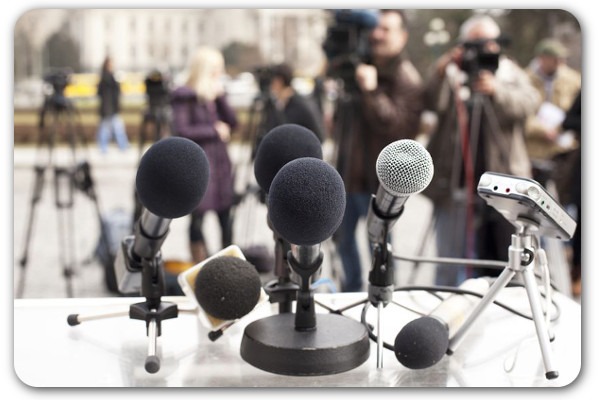Set the stage for a winning press conference that doesn’t bore
Create an optimal atmosphere with reporters in mind.

No one sets out to hold a bad press conference. But it does happen. And that can lead to burned goodwill with employees or simply holding a party that no one attends.
“I am very opinionated about press conferences because I don’t like them,” Jay Geer, president of Miller Geer & Associates, told PR Daily. He admits they can be effective, especially for politicians, government agencies or notable people. But he said he cringes when most agency clients suggest a press conference.
“There’s a certain amount of hubris that goes with thinking the media is going to show up to hear you say something,” he explained. “Even if you have something really important to say. There are other ways in dealing with it.”
If you must hold a press conference, however, you’ve got to get certain factors right — like the details.
Include the deets
Logistical steps to help reporters goes a long way. Does a press kit at the event include links for B-roll, photos, a website or press releases with more information?
While press releases are a popular mode to get the word out, Geer says to stick with media advisories (press releases are too long) for press conferences and give reporters the who, what, where, when, why and how at the event.
“Give what the news is, why it’s relatable and it needs to tie into the day or at least something relevant in the news,” Geer said.
Nicole Gainer, associate vice president at Red Thread PR x Brownstein Group, said that media advisories should include names of prominent attendees to attract a bigger crowd. Also ensure that those who are speaking know what they are saying and preparing remarks for them – and don’t let speakers’ comments overlap one another.
Now that you’ve (hopefully) enticed the press, let’s get the timing down.
At the right time
Geer said that holding press conferences on a Thursday at 10 a.m., for example, is a bad idea because the event is now competing with everything else going on at that time.
“If something else is breaking or it is a hot news day, your stuff could be important but nobody’s going to come,” Geer said. “I’ve been embarrassed at press conferences even for the city when no reporters showed because there was breaking news.”
Gainer said holding it earlier is not necessarily better because most broadcast stations have meetings with their newsroom first thing in the morning.
“You wouldn’t want to plan a press conference, 8:30, 9 a.m.,” Gainer said. Later is better according to the pros.
Geer suggested if a press conference time does not work out, either reschedule it or rethink the purpose of it.
Consider pairing it with an exclusive story featured in a newspaper the day of the event.
“Print drives the electronic media, so I want that story to break the morning of my press conference so other media when they get in in the morning they see my story,” Geer said. “Now you’ve got momentum. If I can get that embargoed story to break and have a press conference, I’m already successful.”
Consider the timing of how long people speak at press conferences, too. Don’t have five people speak for 10 minutes each. Think about having one person speak for about five minutes and offer the press one-on-one interviews with two to three experts so there are not a “bunch of talking heads,” Greer advised.
Press conferences should, overall, be short and sweet – around 15 minutes, keeping reporters’ busy schedules in mind, Geer suggested.
“What they really want is one-on-ones and they want B-roll. Make it visual. They don’t want a picture of someone talking.”
Setting the right mood
From ensuring that good visuals elevate the scenery and provide print or digital content for reporters, photographers and videographers to creative staging – take an extra moment to make your press conference pop.
Gainer said that she’s all about creating a dynamic space for reporters at press conferences with memorable, intentional moments.
“One of the things that we try to do is keep in mind that the media get invited to press conferences every single day,” Gainer said. “What we like to do is bring a little theater to our press conferences. I think about how we can take a traditional announcement and take a non-traditional approach. That really starts with thinking about the visual that we can share with the media and think about branding.”
Gainer shared how one of her clients held a press conference for Legoland Discovery Center opening at a mall in Pennsylvania.
“We had several announcements and we started with a groundbreaking,” Gainer said. Instead of having a traditional groundbreaking press conference showing project partners with hardhats and shovels scooping out clumps of dirt, Gainer said they chose 50,000 LEGO blocks instead of dirt. Instead of real construction workers or executives doing the digging, kids in hard hats scooped out mounds of colorful bricks.
“We partnered with a nearby school because (LEGO) wanted to start building their relationship with schools,” Gainer said. “It just created a great visual for the media.”
Geer has also found success in featuring kids in press conferences.
He recently had a school-based health press conference and had children playing on a school campus playground in the background as opposed to having the announcement in an office.
“It was very effective,” Geer said. “You got to think, ‘I’m a photographer, what do I need? You got to do the press conference in the environment you’re talking about.”
Planning goes beyond cute visuals but strategic ones, too, for prominent brand exposure. Geer said to make sure podiums have a brand’s logo and there are risers in the back of the room for TV cameras and they’re situated above the audience.
“I’ve seen badly staged ones,” Geer said. “They don’t put any thinking into it. They’re worried about what kind of chairs to put out for the press and forget about the riser, or step and repeat or logo. Really do hard thinking, ‘Is anybody going to come to this? I start with that question: ‘Who cares about this.’ And work backward from that.”
Sherri Kolade is a writer at Ragan Communications. When she is not with her family, she enjoys watching Alfred Hitchcock-style films, reading and building an authentically curated life that includes more than occasionally finding something deliciously fried. Follow her on LinkedIn. Have a great PR story idea? Email her at sherrik@ragan.com.







